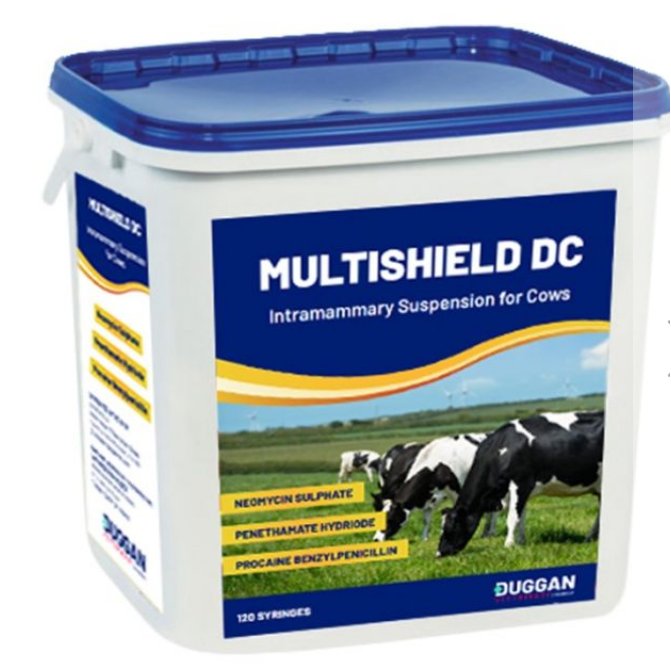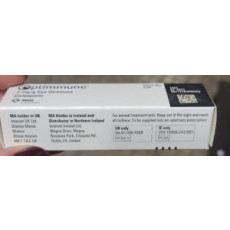Multishield DC, POM-V
![]() Available
Available
Product Description
Multishield DC
Each 4.5g intramammary syringe contains Active Substances: Neomycin 70 000 IU (corresponding to Neomycin Sulphate 100 mg) Penethamate 77.2 mg (corresponding to Penethamate Hydriodide 100 mg) Benzylpenicillin 227.2 mg (corresponding to Procaine Benzylpenicillin 400 mg) Excipients: For the full list of excipients, see section 6.1. 3.
PHARMACEUTICAL FORM Intramammary suspension. A smooth, off white, oily suspension.
CLINICAL PARTICULARS 4.1 Target species Cows (at dry off) 4.2 Indications for use, specifying the target species In cows at drying off: Treatment of subclinical mastitis caused by bovine mastitis microorganisms susceptible to the combination of active substances, penicillin and neomycin, and as part of strategy for the prevention of new infections occurring during the dry period. 4.3 Contraindications Do not use in lactating cows. Do not use in cases of hypersensitivity to β-lactam antibiotics, cephalosporin antibiotics, neomycin or other aminoglycoside antibiotics or to any of the excipients. Do not use in cows with clinical mastitis. 4.4 Special warnings None. Revised: October 2018 AN: 00818/2018 Page 2 of 6
4.5Special Precautions for Use Special precautions for use in animals Use of the product should be based on susceptibility testing of the bacteria isolated from the animal. If this is not possible, therapy should be based on local (regional, farm level) epidemiological information about susceptibility of the target bacteria. Official, national and regional antimicrobial policies should be taken into account when the product is used.
The therapeutic efficacy of the product is only established against pathogens that are susceptible to the active substances. Serious acute mastitis [potentially lethal] due to pathogens like Pseudomonas aeruginosa, can occur after drying off despite preventive treatment. Good aseptic practices should be thoroughly respected in order to reduce that risk; cows should be housed in a hygienic paddock far from the milking parlour and regularly checked several days after drying off. Use of the product deviating from the instructions given in the SPC may increase the prevalence of bacteria resistant to benzylpenicillin and may decrease the effectiveness of treatment with other beta lactam antimicrobials (penicillins and cephalosporins) due to the potential for cross-resistance. Special precautions to be taken by the person administering the veterinary medicinal product to animals Persons administering the product should avoid contact with this preparation as occasionally skin allergy may occur. Penicillins and cephalosporins may cause sensitisation following injection, inhalation, ingestion or skin contact. Sensitivity to penicillins may lead to cross sensitivity to cephalosporins and vice versa. Allergic reactions to these substances may occasionally be serious.
Do not handle this product if you know that you are sensitised or if you have been advised not to work with such preparations. If you develop symptoms such as a skin rash following exposure, seek medical advice and show this warning to the doctor. Swelling of the face, lips or eyes, or difficulty with breathing are more serious symptoms and require urgent medical attention. 4.6 Adverse reaction (frequency and seriousness) Allergic reactions (allergic skin reactions, anaphylaxis) Penicillins may cause hypersensitivity following administration. Allergic reactions to these substances may occasionally be serious. The frequency of adverse reactions is very rare. The frequency of adverse reactions is defined using the following convention: - very common (more than 1 in 10 animals treated displaying adverse reaction(s)) - common (more than 1 but less than 10 animals in 100 animals treated) - uncommon (more than 1 but less than 10 animals in 1,000 animals treated) - rare (more than 1 but less than 10 animals in 10,000 animals treated) - very rare (less than 1 animal in 10,000 animals treated, including isolated reports). Revised: October 2018 AN: 00818/2018 Page 3 of 6 If adverse reactions occur, the current treatment should be withdrawn and symptomatic treatment should be initiated.
4.7 Use during pregnancy and lactation The product is not recommended for use in lactating cows, except at the drying off stage. 4.8 Interaction with other medicinal products and other forms of interactions No data available.
4.9 Amounts to be administered and administration route Single intramammary administration. 100 mg of neomycin sulphate, 100 mg of Penethamate Hydriodide and 400 mg of Procaine Benzylpenicillin into each quarter. The contents of one syringe should be infused into each quarter via the teat canal immediately after the final milking of a lactation. Before instillation, the udder should be milked out completely. The teat and its orifice should be thoroughly cleaned and disinfected with a cleaning towel. Care should be taken to avoid contamination of the injector nozzle. Gently insert the content of one syringe into each quarter. Disperse the product by gentle massage of the teat and udder. The syringe must only be used once.
4.10 Overdose (symptoms, emergency procedures, antidotes) (if necessary) Overdosing may invalidate the stated milk and meat withdrawal times.
4.11 Withdrawal period(s) Meat and Offal: 28 days. Milk: 96 hours post calving in cows with a dry period of more than 50 days. 50 days plus 96 hours after treatment from cows with a dry period of 50 days or less.
Loyalty Scheme
Earn up to 234 loyalty points with this product.





Share
Multishield DC, POM-V
Facebook Twitter Email Pinterest Telegram